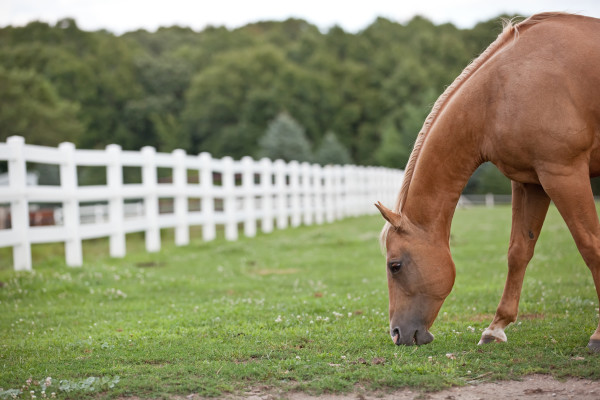Home > Horse Care > 5 ways to prevent sand colic
5 ways to prevent sand colic
- October 6, 2025
- ⎯ Equus
Horses who graze on loose, sandy soil are at risk of sand colic, which can occur if they ingest too much dirt with their forage. The consequences of sand colic can range from very mild, transient digestive upsets, when the particles irritate the gut wall, to impactions or twists (volvulus), which can occur if large amounts of sand settle out of the ingesta and accumulate in the large intestine.

One simple test you can do to determine if your horse is ingesting sand with his forage is the “fecal sand test.” Take six to eight manure balls from the middle of a fresh pile (to make sure it’s not contaminated with sand from the ground) and place them in a plastic bag, jar or bucket of water. Shake or stir to break up the balls, and let the mixture sit for about 15 minutes. If more than a teaspoon of sand has settled on the bottom, your horse is probably consuming dangerous amounts. But be aware that the absence of sand does not mean your horse is not in danger: If the sand has settled down in his gut, it may simply not be moving out with the manure.
Click here to learn the facts of about sand colic.
In one 2012 survey of 62 horses referred to university hospitals for sand colic, only 48 percent had significant amounts of sand in their manure. Short of exploratory surgery, radiographs are the best way to detect large accumulations of sand in a horse’s gut. Rectal exams may be ineffective because the sand often settles too low in the abdomen for the veterinarian to reach. Periodic radiographs may be a good idea for horses who are especially at risk for sand colic.
But a better strategy is to take steps to prevent horses from ingesting and accumulating too much sand in the first place.
Here’s what to do for sand colic:
1. Don’t place hay or feed directly on the ground. A head-down grazing position may be best for a horse’s respiratory health, but you don’t want him picking up dirt with his feed, either. Buckets, tubs and a variety of commercial or homemade feeders can keep hay and grain off of the dirt. Also be careful of spilled hay and feed. Pouring a concrete pad or laying down rubber mats under feeders can help keep even dropped feed clean. Keep in mind that a horse can ingest sand when fed in a riding ring or some dry lots, too.
2. Keep your pastures healthy. Horses turned out on pastures with sandy soils are also prone to picking up grit as they graze. The risk is greater when the grasses are cropped too short—the horses are more likely to consume the plants roots and all. If your pasture is thin or overgrazed, consult a local extension agent for advice on how to help it recover. For example, rotational grazing—moving horses among different turnout areas to give the grass time to recover—can help keep pastures healthy. Offering supplemental hay can also reduce pressure on the grazing.
3. Feed ample forage. A hay- and grass-based diet is healthiest for a horse for many reasons, one of which is that a steady supply of roughage moving through the intestine helps push any ingested sand out with the manure before it can settle. Allowing free-choice hay helps keep things moving around the clock. A slow feeder or hay net can reduce waste and make a hay or feed ration last longer.
4. Add psyllium to your horse’s ration. Psyllium is a high-fiber dietary laxative made from the husk of seeds from a shrub-like herb called Plantago ovata. It is the active ingredient in Metamucil and other human laxatives, as well as a number of products formulated for horses. When psyllium is mixed with water, each particle swells with a gel-like coating. It is believed that the psyllium gel sticks to the sand particles as it moves through the intestine, trapping them and helping to carry them out with the manure. One 2008 study did show that psyllium mixed with mineral oil removed significantly more sand from a horse’s gut than did mineral oil alone. Data from other studies has been less conclusive, but one thing is clear: Psyllium alone won’t avert a serious colic if a horse has already accumulated a large amount of sand. That said, however, routine use of psyllium may help to prevent any ingested sand from building up to dangerous levels. If you choose to add psyllium to your horse’s regimen, read the label carefully and follow the dosage directions. It’s important to feed psyllium only periodically when the goal is to move sand—if fed daily over a long period of time, the horse’s gut will adapt to digest the psyllium in a way that makes it ineffective for that purpose.
5. Encourage your horse to drink lots of water. We all know that our horses need access to ample amounts of fresh, clean water at all times. But good hydration, along with a forage-based diet, also helps keep the intestinal contents moving. When the ingesta loses moisture and slows down, the sand can settle out more readily.
Don’t miss out! With the free weekly EQUUS newsletter, you’ll get the latest horse health information delivered right to your in basket! If you’re not already receiving the EQUUS newsletter, click here to sign up. It’s *free*!
This article first appeared in EQUUS issue #444.





